I got my biggest a-ha this year when I realized that almost everyone makes the same mistake when they try to stand up straight and maintain good posture.
I also did it and it’s a mistake that actually sets you up for future problems with alignment and muscle imbalances throughout your upper body.
I've been studying Katy Bowman’s work closely and I’m nearing the end of my first year of her two-year Restorative Exercise™ certification program.
After many lightbulb moments during this training, there have been two constant themes that keep me smacking myself in the forehead regularly: this stuff is so simple and it’s incredibly hard to do!
What I've learned over the last year has completely changed how I see alignment and my approach to working with people.
Coming from a Pilates background where the focus is the spine and creating good posture, this rib alignment realization has turned everything I thought I knew about alignment on its head and been incredibly humbling in the best possible way.
If you have chronic tightness in your back or neck, this post is especially relevant for you. It requires the willingness to look at posture and your body through a new lens, so buckle up, here we go.
 In her book, Move Your DNA, Katy Bowman talks about what happens on a cellular level with movement and just how important the variety of movements we make, and the environment we move in are for whole-body health and function.
In her book, Move Your DNA, Katy Bowman talks about what happens on a cellular level with movement and just how important the variety of movements we make, and the environment we move in are for whole-body health and function.
Modern conveniences like cars and the grocery store make life easier on so many levels and the fact that you're reading this post on the internet right now is pretty amazing. There are so many positive things that have come with the technology we enjoy.
On the flip side, however, we no longer have to use our bodies even close to their fullest potentials and as a result, we’ve become a fairly sedentary culture.
We don’t have to climb for survival to get away from predators or spend time foraging for food like we used to. We don't have to walk long distances since we have cars, and now, when we do walk, we wear shoes that are too narrow and have elevated heels and this changes our body’s natural ability to move.
Less movement has also created some culturally specific alignment faults in the form of internally rotated femurs and humeral bones, tucked pelvises, sacrums that are falling into the pelvis, near-sightedness and collapsed thoracic spines.
“Human diseases are repeatedly explained to us in terms of their chemical or genetic makeup; meanwhile, we’ve completely ignored the load profile that the function of our body depends upon. As far-fetched as this may sound, we … are animals in captivity, and our tissues are not suited to the loads created through the way we move in our modern habitat.”
Katy Bowman draws an interesting parallel between our reduced movement and ranges of motion and the floppy dorsal fins of male orca whales kept in captivity for extended periods of time.
Orca whales don't have a specific muscle for holding up the dorsal fin.
The loads and forces generated by the environment the whale swims in are what keep the dorsal fin erect. By swimming great distances at a variety of depths in the ocean the whale’s muscles are maintained optimally and allow the dorsal fin to naturally keep its shape and position.
Whales in captivity lose the environmental forces created by their natural movement resulting in a dorsal fin that flops over.
Katy compares this floppy-fin phenomenon to our own physical problems we’ve accepted as normal and signs of aging we take for granted, but which are, in fact, due to specific alignment faults in our culture.
“A forward-falling spine is similar to the captive orca's fin in that it is a collapse allowed by the absence of certain kinds of movement. The spine, like the fin, does not hold itself up directly, but rather calls on the surrounding muscular tones and tensions—a particular pattern of strengths that arises from moving in a natural way.”
Solving the Collapsed Thoracic Spine Problem
Since we don’t have to climb, support our body weight with our arms, or vary our upper body movement much at all, we're missing out on many of the movements required to keep our spine from falling forward.
Add to this the fact that most of our daily movements keep our arms out in front of our body (reading, writing, computer use, driving, cooking, etc.) and you see that we keep a fairly constant pull forward on the front of our spine. As a result, our thoracic spines have secretly collapsed forward. Unconscious of it, we hide the collapse through what we think is good posture.
There's a Difference Between Posture and Alignment
Posture has to do with how something looks or appears, and alignment deals with how something functions when moving.
Most of the time what looks like good posture is actually the ribs being thrust forward creating a shear on the spine, and/or the shoulder blades being squeezed together. While these movements might look like good posture, this is actually an unsustainable alignment and it creates chronic tightness that can eventually lead to joint dysfunction and pain.
Hyper-kyphosis is the word used to describe an excessive rounding in the upper back, which is usually equated with the elderly or aging, but if you're living in a culture with grocery stores and cars, chances are pretty high that there's a collapse in your thoracic spine that you're masking with good posture. Katy calls this hidden kyphosis.
A Quick Exercise
Go ahead and sit up straight right now…
What was your strategy? Did you lift your chest or pull your shoulders blades together? Did you do both?
It may look like you just gave yourself good posture, but if you used the strategy above, all you did was lift your entire rib basket forward by shearing on a vertebra and squeezed your shoulder blades together.
Lifting the ribs this way doesn't create articulation in your thoracic spine the way you may think, it just takes the curve in your upper back and tilts it up, but the curve is still there.
Test Yourself for Hidden Kyphosis
How To Find Your Rib and Pelvis Alignment
1. Stand with your back to a wall and your heels about six inches away from the wall.
2. Next, find your neutral pelvis by aligning your ASIS (anterior superior iliac spine—what most of us call the front of our hip bones) up in the same vertical plane as your pubic bone.
3. Now, check the space between your back and the wall, especially the base of your ribs. There should be space between the wall and your lower back, but if there’s a lot of space behind the base of your ribs, your ribs are thrusting forward.

4. Bring the base of your ribs to the wall by lightly rolling the front of your ribs through your body and into the wall behind you.
5. Double check that you haven’t tucked your pelvis, squeezed your bottom or flattened out your low back.
6. Do you feel rounded over, or are you staring at the floor? This is hidden kyphosis. See what I mean about this being humbling work?!

Ideally the base of your ribs align directly over the bowl of your pelvis.
After studying Katy’s work I needed to see and prove to myself in my own body, as well as with clients, that this hidden kyphosis was a real issue. After working with people consistently on this for over a year, I have found that Katy is spot on and I’ve been amazed by the progress people are making when they work with their kyphosis instead of masking it.
Dropping the ribs to bring them into true alignment and working from there has turned on connections in people’s bodies in ways I could never achieve.
As for the shoulders and arms, this discovery has been a total game changer here too. People unconsciously thrust their ribs outward to get more of what they think is shoulder mobility when taking their arms overhead. The reality is the range of motion isn't coming from their shoulders at all, it's coming from the rib thrust and shear on their spines to lift their arms.
The Arm Exercise
1. Go back to the wall alignment exercise above and see how high you can lift your arms without letting the base of your ribs leave the wall.
2. Now go ahead and let your ribs leave the wall and see how much further you can lift your arms.

You may be able to lift your arms further when you let your ribs lift, but the only way to develop more range of motion in your shoulders is by keeping your ribs down and working from there.
So What Do I Do If I Have Hidden Kyphosis?
If you just discovered that you have a hidden kyphosis, like me, don't worry that you need to walk around all slouched over looking at the ground, but you do want to stop lifting your ribs all of the time.
And if you really want to improve the alignment of your upper spine and shoulders you absolutely must stop blowing past your alignment boundaries in your current Pilates routine and other exercise programs.
 This means propping yourself up for supine exercises to get your ribs in true alignment with your pelvis and being diligent when exercises require you to take your arms overhead. Your arms may not go up as high and that’s okay.
This means propping yourself up for supine exercises to get your ribs in true alignment with your pelvis and being diligent when exercises require you to take your arms overhead. Your arms may not go up as high and that’s okay.
If you ignore your current alignment boundaries, you also completely miss the areas that need to be activated and strengthened—the same areas that will eventually create the true and lasting changes you want.
Most importantly, start dropping your ribs when you’re sitting and standing. You don’t have to drop them as far as you did in the wall exercise, but start dropping them halfway.
Keep an eye on your pelvis. In the beginning it can be tough to drop your ribs without simultaneously tucking your pelvis. Dropping your ribs shouldn’t move your pelvis. Also be patient with yourself. This takes practice!
One specific exercise you can add to your day right away is hanging from a tree branch, door frame, playground bar or Cadillac rail. Make sure you keep your feet on the ground to support your body weight.

Hanging is a great way to recover some of the positive forces we’ve lost due to our modern lifestyle and balance our modern-day human bodies.
 And if you don't have a place to hang inside, a small tree can be an excellent way to get your hanging sessions in, plus it's a great excuse to get outside a little more often!
And if you don't have a place to hang inside, a small tree can be an excellent way to get your hanging sessions in, plus it's a great excuse to get outside a little more often!
I’ll be posting more exercises to help alleviate hidden kyphosis as well as taking a closer look at some of the other alignment faults Katy talks about and applying this knowledge directly to Pilates. In the meantime, if you are interested in learning more check out Move Your DNA.
See you in the studio!
Sydney


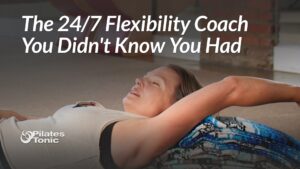
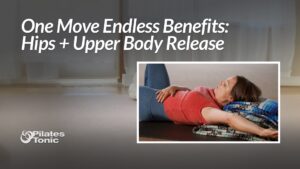
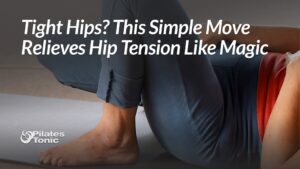
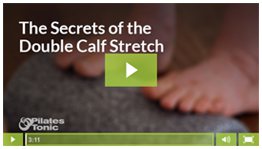

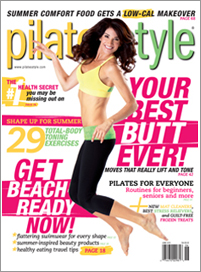
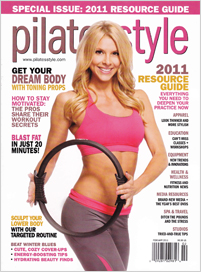
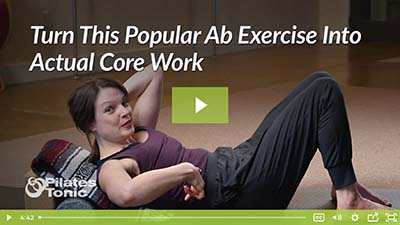
10 Responses
Thank you, Sydney. I loved this post. It occurs to me that many people may also lack the muscle strength in the upper gluteus, the part that connects into the lower back, and that this contributes to the imbalance that leads to thoracic collapse/thrusting out the ribs. If you looks at runners or dancers with good alignment, they seem to be moving from that center of gravity spot, and the muscles above that center of gravity seem to be almost weightless. I think that is part of the explanation why, as you astutely pointed out, it’s incredibly hard to do but seems effortless. Thanks and please keep this series coming. It’s hugely helpful.
Thank you Miriam! I’m so glad you found this post helpful and I completely agree about the missing glute strength/connection!
Thanks for sharing this! I found my left was okay and actually aligned very easily but my right is another story altogether!
So interesting to make that discover! Thanks for sharing Usagi!
Great article! I love learning more about my ribs/spine/shoulders as I am a equestrian whose focus is in dressage where body awareness and alignment are crucial to communicating with my horse.
So glad you found this article helpful Lisa. Thanks for sharing!
Great article. I would love and be curious to see some more exercises to treating hidden kyphosis if you ever get the chance, would really appreciate it. Thanks!
Thanks for your feedback Barrett! I’ll keep it mind for sure.
All of the things you said are correct. I had massive injury from something I’m not sure what and I thought to fix it by correcting my posture. Well it turns out all my posture adjustments added up to a severe rib flare. To the point where I was having trouble breathing. I’ve gotten extremely strong but the pain was still there, finally in a hospital, laying on a fold out bed waiting for my 3rd baby. I accidentally tucked my ribs and all of a sudden something in my brain unlocked. I had been holding my ribs flared out for the past 2 years and now for the last 4 days I have been tucking my ribs all day, it is extremely exhausting but I have had no issues. I look at myself in the mirror and while I do notice that my shoulders are looking rounded my neck is directly over my pelvis and not in some crazy hyperextension. I actually injured my lower back in my early twenties and developed a severe case of lordosis to fix the pain in my lower back, 10 years later I never fixed the lordosis and it just eventually took over. Posture is a sham, well at least the superficial idea of it is. I can’t express how important it is when you flex backwards or “stand tall”, you tuck the ribs at all positions.
Wow, thanks so much for sharing and I hope you keep feeling better and better!